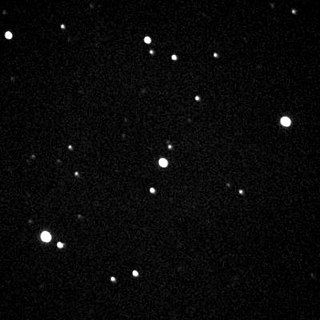
An exomoon or extrasolar moon is a natural satellite that orbits an exoplanet or other non-stellar extrasolar body.

XO-1b is an extrasolar planet approximately 536 light-years away from Earth.

WASP-2b is an extrasolar planet orbiting the star WASP-2 located about 500 light years away in the constellation of Delphinus. It was discovered via the transit method, and then follow up measurements using the radial velocity method confirmed that WASP-2b was a planet. The planet's mass and radius indicate that it is a gas giant with a similar bulk composition to Jupiter. Unlike Jupiter, but similar to many other planets detected around other stars, WASP-2b is located very close to its star, and belongs to the class of planets known as hot Jupiters. A 2008 study concluded that the WASP-2b system is a binary star system allowing even more accurate determination of stellar and planetary parameters.

WASP-1 is a metal-rich magnitude 12 star located about 1,300 light-years away in the Andromeda constellation.
WASP-2 is a binary star system in the Delphinus constellation located about 500 light-years away. The primary is magnitude 12 orange dwarf star, orbited by red dwarf star on wide orbit. The star system shows an infrared excess noise of unknown origin.

WASP-3b is an extrasolar planet orbiting the star WASP-3 located approximately 800 light-years away in the constellation Lyra. It was discovered via the transit method by SuperWASP, and follow up radial velocity observations confirmed that WASP-3b is a planet. The planet's mass and radius indicate that it is a gas giant with a similar bulk composition to Jupiter. WASP-3b has such an orbital distance around its star to classify it in the class of planets known as hot Jupiters and has an atmospheric temperature of approximately 1983 K.
WASP-10 is a star in the constellation Pegasus. The SuperWASP project has observed and classified this star as a variable star, perhaps due to the eclipsing planet.

WASP-14b is an extrasolar planet discovered in 2008 by SuperWASP using the transit method. Follow-up radial velocity measurements showed that the mass of WASP-14b is almost eight times larger than that of Jupiter. The radius found by the transit observations show that it has a radius 25% larger than Jupiter. This makes WASP-14b one of the densest exoplanets known. Its radius best fits the model of Jonathan Fortney.
WASP-14 or BD+22 2716 is a star in the constellation Boötes. The SuperWASP project has observed and classified this star as a variable star, perhaps due to the eclipsing planet.
WASP-3 is a magnitude 10 yellow-white dwarf star located about 800 light-years away in the Lyra constellation. It appears to be variable; it "passed from a less active to a more active state between 2007 and 2010".

WASP-16b is an extrasolar planet that travels around its star, WASP-16, every 3.12 days. Likely a hot Jupiter. Its mass is near .855 of Jupiter, the radius is 1.008 of Jupiter. It was discovered in 2009 by a team led by T.A. Lister as part of the Wide Angle Search for Planets project.
WASP-16 is a magnitude 11 yellow dwarf main sequence star, with characteristics similar to the Sun, located in the Virgo constellation.
WASP-18 is a magnitude 9 star located in the Phoenix constellation of the southern hemisphere. It has a mass of 1.25 solar masses.
WASP-19 is a magnitude 12.3 star located in the Vela constellation of the southern hemisphere. This star has been found to host a transiting hot Jupiter-type planet in tight orbit.

HD 15082 is a star located roughly 399 light years away in the northern constellation of Andromeda. The star is a Delta Scuti variable and a planetary transit variable. A hot Jupiter type extrasolar planet, named WASP-33b or HD 15082b, orbits this star with an orbital period of 1.22 days. It is the first Delta Scuti variable known to host a planet.

Transit-timing variation is a method for detecting exoplanets by observing variations in the timing of a transit. This provides an extremely sensitive method capable of detecting additional planets in the system with masses potentially as small as that of Earth. In tightly packed planetary systems, the gravitational pull of the planets among themselves causes one planet to accelerate and another planet to decelerate along its orbit. The acceleration causes the orbital period of each planet to change. Detecting this effect by measuring the change is known as transit-timing variations. "Timing variation" asks whether the transit occurs with strict periodicity or if there's a variation.
WASP-24 is an F-type star with the Hot Jupiter planet WASP-24b in orbit. WASP-24 is slightly larger and more massive than the Sun, it is also has a similar Metallicity and is hotter than the Sun. WASP-24 was first observed by the SuperWASP planet-searching organization, which flagged it as a potential host to a planet before following up with radial velocity and spectral measurements. Analysis of these confirmed the planetary nature of WASP-24b, which was later released to the public on the SuperWASP website.

WASP-31b is a low-density (puffy) "hot Jupiter" extrasolar planet orbiting the metal-poor dwarf star WASP-31. The exoplanet was discovered in 2010 by the WASP project. WASP-31b is in the constellation of Crater, and is about 1305 light-years from Earth.
HD 146389, is a star with a yellow-white hue in the northern constellation of Hercules. The star was given the formal name Irena by the International Astronomical Union in January 2020. It is invisible to the naked eye with an apparent visual magnitude of 9.4 The star is located at a distance of approximately 446 light years from the Sun based on parallax, but is drifting closer with a radial velocity of −9 km/s. The star is known to host one exoplanet, designated WASP-38b or formally named 'Iztok'.











